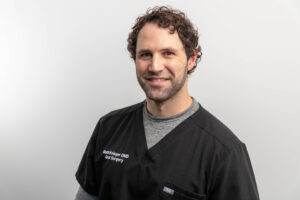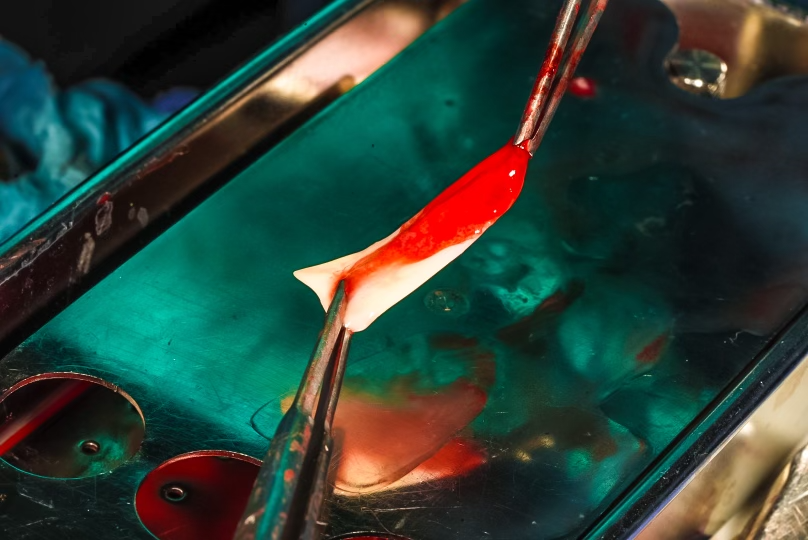Archived Newsletter Re-Post.
The AOX Newsletter • March 2024 #10
I absolutely love Platelet Rich Fibrin.
I have found it to be incredibly beneficial in All-On-X surgery.
Furthermore, PRF comes at almost no cost to the practice and requires no additional surgical intervention for the patient.
While I don’t use PRF on every AOX patient, I do use it frequently.
Listed below are the 3 most common instances in which I utilize PRF during All-On-X surgery.
1. PRF is my go-to when there is ANYTHING in, on, or around the maxillary sinus.
This is where I feel PRF truly shines. If I have a sinus perforation following extractions and/or bone reduction – you better believe that site is going to be covered by a flattened PRF clot. Along with primary closure, this virtually always ensures adequate sinus healing of even notable size OA communications.
I also utilize PRF any time I perform a sinus lift/graft in conjunction with AOX surgery. The flattened clot is used to cover any membrane perforation at the graft site, as well as utilized to cover the graft itself prior to application of a collagen membrane.
If the sinus is involved – I’m using PRF.
2. PRF is applied over/around any defect requiring a bone graft.
As I have mentioned prior, I do not routinely perform bone grafts during All-On-X surgery. A graftless surgery is one of the benefits of the AOX procedure.
However, I do save autogenous bone reduction shavings for use around any notable bony defects adjacent implant sites.
If I am applying any bone graft to a defect, I also cover the bone graft itself with a flattened PRF membrane.
I do not necessarily cover the graft with a collagen membrane, unless the graft is of significant size. And even in that case, I will still cover the graft initially with a PRF clot, and then apply the collagen membrane over the clot itself.
3. PRF is used in place of bone at any implant adjacent site presenting with pathology.
In the setting of pathology in or around an implant site, such as notable periapical pathology (with concern for acute infection at a potential graft site) or a benign cyst, I prefer to place PRF at the site of the lesion / cyst enucleation as opposed to bone graft material. (This typically does not include minor, routine peri-apical lesions easily enucleated).
When AOX patients present with pathology other than routine periapical lesions, I typically perform 2 biopsies on these full-arch patients.
First, I complete an incisional biopsy prior to AOX surgery for an initial diagnosis and to confirm that it is reasonable to proceed with AOX surgery. I then perform a more substantial excisional biopsy (and definitive treatment as indicated) for a secondary confirmation of the pathologic diagnosis during AOX surgery.
Because I am confirming the diagnosis, and because some benign cysts can recur and/or may require further treatment – I personally do not like to occlude or cover up the area with a large amount of bone graft material. I feel that PRF is a great alternative to a traditional graft in this situation.
I feel this is an advantage of AOX surgery as this procedure is typically a graftless surgery. Therefore I attempt to eliminate the risk of a graft that may impair definitive pathologic treatment and/or become secondarily infected at the site of known pathology.
This is obviously patient dependent, case dependent, and dependent on my gut intuition of the pathologic diagnosis and the initial biopsy diagnosis. This is absolutely not a blanket statement on how to handle oral pathology. Please rely on your surgical training and expertise or a referral to an oral & maxillofacial surgeon as indicated.
*Note that there are also times when I will not place anything (including PRF) at the site of pathology. This is an intra-operative clinical decision and is also based on my current/working diagnosis of the pathology at hand.
Listed above are only a few of the many uses of Platelet Rich Fibrin in AOX surgery. PRF is incredibly versatile and has many applicable and powerful uses in All-On-X surgery.
And despite it’s array of benefits, it remains something so simple and cost effective to use.
Here’s to the wonders and magic of the affectionately named…”Snot Clot”.
Matthew Krieger DMD
P.S.
I used to utilize the “poncho” technique on all my AOX implants, whether or not a bone graft was required. This is a technique whereby a small slit was placed into the flattened PRF membrane and the membrane was then draped over the healing abutment and seated down around the implant/alveolar crest interface.
I have done ~750 arches with this technique and ~1, 275 arches without. I have not noticed a clinical difference in healing in either scenario. Therefore, I have moved to only utilizing the “poncho” technique when the PRF is going to cover an immediately adjacent implant graft site.
“I was just thinking about snot.”
Michael Scott – Dunder Mifflin Paper Company
Q & A with Dr. K

“Do you do all of your extractions at the same time?” |
No.
I perform my maxillary extractions first. I then perform my maxillary incision & flap reflection. Finally I complete my maxillary bone reduction.
At this time, I move down to the mandible where I repeat the exact same process.
Implants are then placed after both bone reductions are complete.
In my hands, I find bleeding on the mandible to be a bit more “annoying” on a more consistent basis than the maxilla.
Therefore, I find it helpful to give the mandible extra time for the local anesthesia & epinephrine to sit
while working on the maxilla. I feel this extra time helps reduce some of the mandibular bleeding I encounter.
This is purely personal preference.
The more important point to take away is that I have a systematic approach I follow. This helps me work confidently and efficiently and also helps ensure my team knows what I am going to do, before I do it.
(Note that there are times I will cut one jaw at a time – and honestly I have recently gone to doing this more frequently… just because it is less stressful).
Archived newsletters are released on a delayed timeline, a few months after the original publication. If you would like to receive these newsletters in real time please sign up here.

